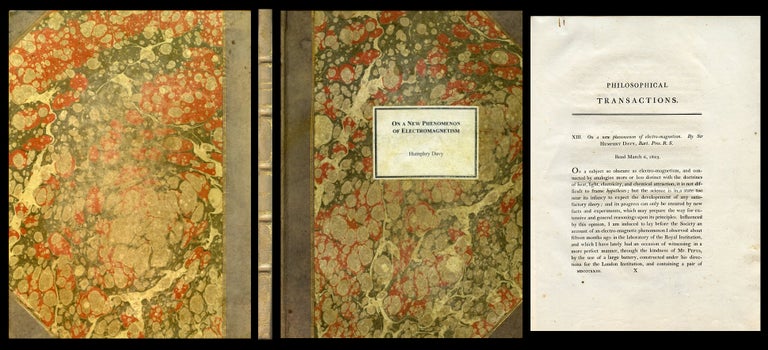On a New Phenomenon of Electro-Magnetism, extracted from Philosophical Transactions of the Royal Society, Vol. 113, 1823, pp. 153-159
London: Royal Society, 1823. 1st Edition. FIRST EDITION EXTRACT of one in a series of papers on electromagnetism published by the British chemist Humphry Davy between 1821 and 1826. Davy’s experiments were based on Oersted's discovery of the relationship between electricity and magnetism in 1820, as well as Wollaston and Faraday’s studies. In this paper, Davy experiments on how mercury responds to the electrical field produced by a battery. The extract has been handsomely bound in half calf over marbled paper boards.
Following Faraday’s “ingenious experiments on electromagnetic rotation, that if mercury could be made to revolve by electromagnetism, [Davy believed] some new light might be thrown upon the subject, as the motions of that substance could not be affected by the disadvantages attending mechanical suspension” (Annals of Philosophy, Volume 5, 1823, 303). First Davy experimented with the effect of the action of a magnet upon mercury connected in the electric circuit. In this work, he repeated the same experiment, but in a more exacting manner and with the aid of a battery that consisted of a single pair of plates oaf about 100 square feet.
“When two wires were placed in a basin of mercury, perpendicular to the surface, and in the voltaic circuit of the above-mentioned battery, the mercury revolved according to the common law of electro-magnetic rotation, upon presenting a magnet either above or below the wires; and the velocity was increased by using the opposite poles of two magnets, one above and the other below the mercury. When the pole of the magnet was held above the mercury, and between the two wires, the circular motion ceased, and currents took place in the mercury in opposite directions” (Abstracts of the Papers Printed in the Philosophical, Volume 1-2, 189).
Davy believed that as electricity passed through the mercury, it created motions that were independent of the magnet and that the rotations were the result of a combination of forces. Furthermore, Davy believed that the motions would, given the positioning of the wires, mainly occur at the lower surface of the mercury. For this reason, he inverted the form of the experiment and brought “the copper wires through two holes in the bottom of a glass basin, with so much mercury in it as to stand one tenth of an inch above the polished ends of the wires.” (ibid).
When the surface of the mercury interacted with the battery, the mercury rose into a small cone above each of the wires; as to the wires, waves flowed from them in all directions and the only area that appeared at rest was between the wires.
“These cones were diminished by the approximation of the pole of a magnet, which produced rotation, and on bringing it near enough, a depression of the mercury above the pole” (ibid 190). Davy believed the phenomenon appeared absolutely independent of any elevation in the temperature of the mercury and he did not believe the reaction the product of electric repulsion. Davy concluded that the reaction “must be referred to forces producing motions in right lines, or undulations from the surfaces of the wires as a centre; and it seems [argues Davy] strongly opposed to the idea of the electro-magnetic results, being produced by the motion of a single imponderable fluid” (ibid). Item #720
CONDITION & DETAILS: First edition, complete bound extract. London: The Royal Society. (11.5 x 9 inches; 288 x 225mm). [2], 153-160, [2]. Very handsomely bound in half-calf over gilt-ruled marbled paper boards, purposefully aged by the binder. Aged paper label on the front board. Five raised bands at the spine, gilt-lettered with gilt-tooling in the compartments. Tightly and solidly bound. Scattered very light toning within. Near fine condition.
Price: $375.00

